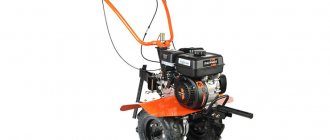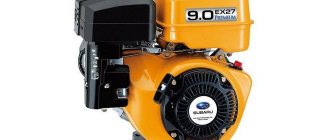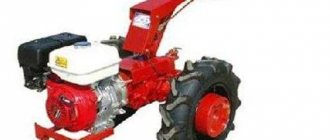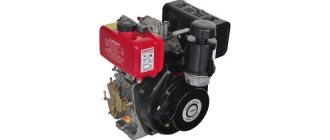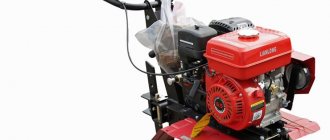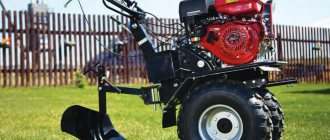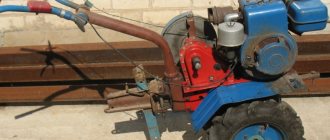Walk-behind tractor ignition device
The ignition system is one of the most important components of both branded and homemade walk-behind tractors. Its main function is to generate a spark, which is needed for ignition and gradual combustion of fuel in the chrome-plated cylinder of the internal combustion engine.
The simplicity of the factory design of the unit allows you to perform your own repair of the ignition of a walk-behind tractor, which, most often, involves setting a gap between its elements. However, to do this correctly, you need to study the design of the unit.
The ignition device of any household agricultural unit includes a coil, which is initially connected to the electrical power supply of the system, as well as a magneto and spark plugs. When starting the power unit of the walk-behind tractor, voltage is supplied, as a result of which a pronounced spark is formed between the magnetic “shoe” and the standard spark plug. It is necessary for instant ignition of the fuel, which at this moment is in the combustion chamber of the engine. The photo will tell you more about the structure of the ignition system of the walk-behind tractor used.
The electronic ignition system of a walk-behind tractor is also often equipped with breakers that are triggered automatically when any unit malfunction occurs. This leads to an emergency shutdown of electrical power in the network.
How to set the ignition on a walk-behind tractor?
The following signs will indicate the need for urgent adjustment of the gap in the ignition system:
- the need to frequently pull the starter cord to no avail;
- delayed reaction of the walk-behind tractor engine to manipulations with the starter;
- complete lack of starting the internal combustion engine of the agricultural unit.
Each of these malfunctions indicates that the operator must install the ignition of the walk-behind tractor used on the farm. The correct procedure for this can be found in the operating instructions for the existing equipment. However, the operator does not always have the manual at hand. In this case, the gap between the built-in ignition module and the flywheel can be set in the following sequence:
- First, the operator must close the spark plug with a special square;
- Then its body will need to be pressed against the head of the standard cylinder of the internal combustion engine;
- Next, the spark plug must be turned in the direction opposite to the hole provided in the end of the chrome-plated cylinder;
- After this, you need to carefully turn the crankshaft of the internal combustion engine of the walk-behind tractor - to do this, just pull the trigger cord;
- As a result of these actions, a bright blue spark should jump between the built-in electrodes. If this does not happen, then it is necessary to check the distance between the magneto and the starter of the walk-behind tractor - it should be from 0.1 to 0.15 mm. If these requirements do not meet these requirements, the gap between the elements will need to be adjusted.
Many experienced users adjust the ignition of a walk-behind tractor by ear. Both contact and non-contact magnetos are suitable for this. To configure the system yourself, you must:
- Start the engine and slightly loosen the standard distributor;
- Slowly turn the breaker in each of the possible directions;
- Achieve maximum speed of the factory engine and quickly secure the structure;
- Listen and find the moment at which a spark instantly appears;
- Turn the breaker until there is a clear clicking sound;
- Fix the standard distributor fasteners.
In some cases, a strobe light will help to correctly adjust the existing gap.
To configure you need:
- Warm up the power unit of the walk-behind tractor;
- Connect the device to the electrical power supply network of the agricultural unit;
- Install the sound sensor on a high-voltage wire connected to one of the cylinders of the standard internal combustion engine;
- Carefully remove the vacuum tube and plug it with any available means;
- See where the light from the strobe will be directed - it should “look” towards the standard pulley;
- Start the engine and leave it idling;
- Scroll the distributor;
- Once the marks on the built-in pulley line up with the mark located on the cover of the device being used, turn the factory breaker nut all the way.
Each of these methods is suitable for adjustment on both gasoline and diesel walk-behind tractors. The main thing in the process of self-tuning is not to remove the coil and other elements of the ignition system - this can lead to disruption of the operation of the entire unit.
About the walk-behind tractor: exchange of experience, maintenance, repairs and attachments
Since the section is ELECTRICAL EQUIPMENT , I’ll start with the main one, this is the electrical circuit of the Motor Sich MB-6 walk-behind tractor.
I want to say right away that I am not a professional electrician and my knowledge is more suitable for auto electrics, so if there are any inaccuracies, please do not be shy and correct me if anything is wrong.
Electrical diagram of the Motor Sich MB-6 walk-behind tractor (taken from the instruction manual)
Electrical diagram of the Motor Sich MB-6 walk-behind tractor (taken from Victor’s video)
Electrical circuit blocking the engine start of the Motor Sich walk-behind tractor (taken from Victor’s video)
Electrical diagram of the Motor Sich MB-6 walk-behind tractor (video by Victor)
If you have any questions or additions, please do not hesitate to write in the comments.
View topics:
Similar
26 comments
Hello everyone. In my MB8 I will have problems again. I don’t want to work in the heat of the moment. By placing the coil out of the mixer it is ideal to protect and show the generator, contactless, what will happen
How to check the ignition coil on a walk-behind tractor?
Most often, this important element of the ignition of a walk-behind tractor is checked using a known working test sample. If during testing it turned out that after installing the sample everything began to work as it should, then the standard ignition coil of the walk-behind tractor is faulty.
However, not everyone has a test sample at hand. If it is not there, then you need to try to check the built-in coil in other ways. Before this, you need to eliminate any damage that may occur in the start button and high-voltage wiring. In addition, the user must carefully study the electrical diagrams, which indicate the location of the ignition system elements.
Further verification methods include:
- measuring the resistance of the built-in ignition coil. It is worth noting that it is not always used by users of agricultural machinery. First, the operator must know the exact parameters of the resistance created by the standard coil. Secondly, in addition to the inductor coil, the design of the ignition system contains semiconductor components required to generate the required electrical impulse. Problems with all these elements can only be identified when they are heated. To properly check the ignition coil, you will need to disconnect the cap and the standard armored wire from it. Knowing the exact resistance parameters of the built-in element, the operator will be able to understand which part of the system is faulty;
- checking the spark being created using a special device - it must be connected to the point where the electrical circuit is broken between the high-voltage wires of the standard coil and the spark plug;
- testing the coil using a spark plug built into the design - to do this, you need to unscrew the built-in spark plug and carefully place its body against the cylinder. Then you need to pull the starter handle and pay attention to the spark that forms between the factory contacts of the spark plug. It should be noted that this method of checking an existing coil is approximate - in this case the spark plug is not under load, which is why there is no compression in the internal combustion engine cylinder. As a result, the standard engine flywheel will rotate faster.
Each of these methods provides approximate information about the condition of the ignition coil. It must be remembered that you can find the exact cause of a part malfunction using specialized testers, which are available only in specialized workshops.
Battery powered lighting
You can make light on a walk-behind tractor without a generator by installing a 12 V battery. The battery from a motorcycle, moped or boat is used as a power source. Don't give up on your car battery. If you put a heavy power source on the cultivator, you can solve several related problems - equip the unit with an electric starter and significantly make its body heavier. In addition, it would be useful to be able to illuminate the area at night without the engine running. This function can be useful on a picnic or night fishing.
Installing the headlight on a walk-behind tractor using a battery is carried out in the following sequence:
- Arrangement of the frame for the power source. It is best to use a steel corner for this. The frame should be attached directly to the frame of the motor-cultivator body. After lowering the battery into the niche, it is firmly secured in it using steel straps.
- Attaching a lantern and auxiliary lights. The headlight is placed on the walk-behind tractor so that it illuminates the widest possible sector without blinding the operator or oncoming vehicles. It is better to choose devices with an adjustable beam angle.
- Location of the electrical cable in the corrugation along the body of the unit. Installation and connection of control devices. Tester checking the correct assembly of the electrical system.
- Connecting the wire to the battery terminals, leading the wire into the junction box. Connecting wires to the switch, insulating joints, joints and twists.
In order for the battery capacity to last for a long time, LED lamps must be inserted into the flashlights. They consume a small amount of energy, creating bright lighting.
If the battery is not located under the standard hood of the walk-behind tractor, then it is necessary to make a separate casing. To do this, you can take a piece of thick plastic, give it the desired shape and screw it to homemade racks on the frame.
When deciding to install a battery, you should consider the issue of recharging it. To do this, you will need to purchase a charger or install an electric generator on the cultivator.
Magneto for walk-behind tractor - testing at home
The magneto on a walk-behind tractor is a structurally complex element that is in constant contact with high-voltage wiring and interacts with electricity. Due to operation of the walk-behind tractor in wet weather, accidental impacts and failures in the electrical power supply, this part gradually fails. Checking it for serviceability is quite simple, but the operator will have to act at his own peril and risk, since the only way to test the part in the field will be very dangerous for the entire ignition system.
To check the magneto of a walk-behind tractor, you will need:
- Carefully remove the cap from the candle screwed into its standard place and insert a small nail in its place. The latter must be clean, without signs of corrosion;
- The nail must be installed at a distance of 7 mm from the cylinder wall of the standard cylinder of the power unit of the walk-behind tractor;
- Start the engine of the agricultural unit;
- Check if a spark appears when starting the engine. It should be painted bright blue and clearly visible. If this is not the case, then the magneto has failed.
If the magneto breaks, it will need to be replaced. You can do this yourself by removing the faulty part and installing a new part.
DIY lighting installation
Manufacturers of special equipment offer spare parts for walk-behind tractors and ready-to-connect lighting kits, consisting of a headlight, a toggle switch and wiring. However, many owners of units prefer to independently prepare and install lighting equipment to avoid additional costs. Installing lighting on a mini-tractor with your own hands does not require special skills, the purchase of expensive materials or the use of special equipment. Headlights from various Soviet-built cars are often used as lighting devices for agricultural machinery.
Note! The brightness of the old flashlight may not be enough for special equipment to go onto the highway or to perform a large amount of work. In addition, the service life of such a device does not exceed 2–3 months.
What to do if there is no spark on the walk-behind tractor?
If after the tests it turns out that the spark has disappeared, then the cause of this breakdown must be sought in the main elements of the ignition system of the agricultural unit.
To do this you will need:
- inspect the spark plug - it needs to be unscrewed using a special key;
- the spark plug may be completely dry - this indicates that fuel is not entering the engine cylinder, that is, the fuel pipes are clogged or the carburetor is malfunctioning;
- in some cases, the part turns out to be wet from gasoline and motor oil. The reasons for this are an excess of lubricant contained in the fuel, or its leakage from the engine oil sump directly into the cylinder. In this case, the operator must remove the spark plug and dry it thoroughly. After this, you need to dry the cylinder, intensively pull the starter cable several times on the engine with the spark plug turned out;
- Most often, due to the lack of proper and timely maintenance of agricultural machinery, a thick continuous layer of soot and dried resinous deposits forms on the spark plug of a walk-behind tractor. To restore the candle, you need to carefully heat it with a lighter and wash off the remaining resin with clean gasoline. After this, the part will need to be dried and screwed into place. If this does not help, then the spark plug needs to be replaced.
It is important to be extremely careful when removing, cleaning, and reinstalling the spark plug. Any careless movement can damage the electrodes of the part, causing it to no longer generate a spark.
Gasoline models
The gasoline line of Centaur walk-behind tractors includes the following modifications:
- Centaur MB-40
- Centaur 2080B
- Centaur MB 2013B
- Centaur MB 2070B
- Centaur 2090B
- Centaur MB 2071B
- Centaur 2016B
- Centaur MB 3060B
- Centaur MB 2091B
We invite you to study the photos, descriptions and characteristics of each modification.
Centaur MB-40
This self-propelled equipment belongs to the household class of devices and is equipped with a single-cylinder power plant with air protection. The MB-40-1 modification has a production power of 7.5 hp, which is provided by the DJ 170 F engine.
Motoblock Centaur MB 40-2
The MB-40-2 and MB 40-3 models are equipped with a DB170N engine with a power of 7 hp. With. A new modification of the Centaur MB-40-1C walk-behind tractor is equipped with a DJ 170 F power plant. The engine is started manually, the gearbox is a two-stage manual with 2 forward gears and one reverse gear.
Characteristics
| Motoblock model Centaur | 40-1 | 40-2 | 40-3 |
| Engine | DJ 170 F | DB170N | DB170N |
| Power | 7.5 hp | 7.0 hp | 7.0 hp |
| Engine displacement | 208 cm3 | 208 cm3 | 208 cm3 |
| Fuel type | petrol | petrol | petrol |
| Starting system | manual | manual | manual |
| Fuel tank capacity | 3.6l | 5.0l | 3.6l |
| Number of gears, forward/backward | 1/1 | 2/1 | 2/1 |
| Cultivation width | 40-70 cm | 45-86 cm | 45-86 cm |
| Cultivation depth | 10-20 cm | 15-30 cm | 10-20 cm |
| Wheels | 13*5.00-6 | 4.00-8 | 4.00-8 |
| Dimensions | 75*41*61 cm | 139*80107 | 139*80*107 |
| Weight | 83 kg | 87 kg | 70 kg |
Centaur 2080B
This household self-propelled device is designed for processing small areas (about 20 acres), equipped with a Japanese-quality Kama gasoline engine with a power of 8 liters. With.
Motoblock Centaur 2080B
Recoil starter launch, forced air cooling. Light weight and compact dimensions make it easy to transport the walk-behind tractor from place to place, as well as to carry out work not only in the open ground, but also in a greenhouse. The manual transmission provides 2+1 speeds.
Characteristics
| Engine power, hp | 8 |
| Fuel type | Petrol |
| Engine starting system (starter) | Manual |
| Connecting an active hitch | PTO (1176 rpm) |
| Engine volume, cm3 | 210 |
| Number of forward gears | 2 |
| Number of reverse gears | 1 |
| Fuel consumption, l/h | 0.9 |
| Max. cultivation width, mm | 1 100 (min. 450 mm) |
| Max. processing depth, mm | 200 |
Centaur 2013B
This modification is intended for cultivating crop areas up to 2 hectares. The walk-behind tractor weighs 132 kg and is equipped with a high-performance 13-liter power unit. With.
Motoblock Centaur 2013B
A special, collapsible cutter allows the operator to independently adjust the tillage width up to 140 cm. The built-in oil level sensor will prevent the Centaur walk-behind tractor from starting if there is insufficient working fluid. Easy start is made from an inertial starter. The present PTO allows you to aggregate active attachments.
Characteristics
| engine's type | Petrol |
| Engine power | 13.0(hp) |
| Engine capacity | 389.0(cc) |
| Engine cooling system | Air |
| Fuel tank volume | 6.5(l) |
| Oil tank volume | 1.1(l) |
| Number of gears | 2 forward/1 reverse |
| Starting system | Mechanical starter |
| Transmission | Gear reducer |
| Clutch | Disc friction |
| PTO | Yes |
| Wheel diameter | 12.0(inch) |
| Minimum processing width | 87.0(cm) |
| Maximum processing width | 140.0(cm) |
| Maximum processing depth | 30.0(cm) |
| Overall dimensions, mm | 870/1130/1400 |
| Weight | 132.0(kg) |
Centaur MB 2070B
The walk-behind tractor allows you to cultivate a plot of land up to 1 hectare. Built-in system for easy starting from a manual starter.
Motoblock Centaur MB 2070B-4
There are several modifications of the walk-behind tractor: 2070B/M2, 2070B/M2-4, 2070B-3, MB 2070B-4.
Motoblock Centaur MB 2070B/M2
Motoblock Centaur MB 2070B/M2-4
Motoblock Centaur MB 2070B-3
Characteristics
| Motoblock model Centaur | 2070B/M2 | 2070B/M2-4 | 2070B-3 | 2070B-4 |
| Engine | 4 stroke | 4 stroke | 4 stroke | 4 stroke |
| Power | 7.0 hp | 7.0 hp | 7.5 hp | 7.0 hp |
| Engine displacement | 208 cm3 | 208 cm3 | 208 cm3 | 208 cm3 |
| Fuel type | petrol | petrol | petrol | petrol |
| Fuel tank capacity | 3.6 l | 3.6 l | 3.6 l | 3.6 l |
| Number of gears, forward/backward | 2/1 | 2/1 | 2/1 | 2/1 |
| Cultivation width | 90cm | 80 | 110 | 110 |
| Cultivation depth | 30 cm | 30 cm | 30 cm | 30 cm |
| Dimensions | 104*50*80 | 150*70*120 | 143*50*82 | 173*95*106 |
| Weight | 90 kg | 90 kg | 123 kg | 106 kg |
Centaur 2090B
The performance of the SH270 engine of this walk-behind tractor is 9 liters. With. This heavy walk-behind tractor is designed for cultivating medium and large sown areas with soil of any gravity.
Motoblock Centaur MB 2090B
Three-position cutter with blade thickness 5 mm. allows you to adjust the width of the soil, the cultivation depth is 15-29 cm. The engine starts inertia, there is a PTO, the load capacity with a trailer is 300 kg. There are 2 forward speeds and reverse.
Characteristics
| engine's type | Petrol |
| Number of gears | 2 forward/1 reverse |
| Engine power | 9 l. With. |
| Engine capacity | 270.0 (cc) |
| Engine stroke | Four stroke |
| Engine cooling system | Air |
| Fuel tank volume | 6.0 (l) |
| Fuel consumption | 0.9 (l/h) |
| Weight | 138.0 (kg) |
| Processing width | 140.0 (cm) |
| Processing depth | 30.0 (cm) |
| The cutter has | 3 stages of regulation |
Centaur MB 2071B
This model is designed for cultivating areas up to 1 hectare. Engine performance DB170E 7 liters. With.
Motoblock Centaur MB 2071B
The center of gravity is specially lowered, which increases the stability of the walk-behind tractor. The cutters are collapsible three-position, speed 2+1. The main controls are located at the steering wheel.
Characteristics
| Weight, kg | 132 |
| Dimensions (LxWxH), mm | 1740/1050/980 |
| Cultivation width, cm | 62-113 |
| Oil volume in the gearbox, l | 1,7 |
| Cultivation depth, cm | up to 30 |
| Number of gears | 2/1 |
| Clutch type | multi-disc |
| Wheel size | 4.00-12 |
| Track width, mm | 565 |
| Type | DB177E |
| Fuel | petrol |
| Engine displacement, cm3 | 207 |
| Cooling | air |
| Oil sump volume, l | 1,1 |
| Fuel tank, l | 3,6 |
| Fuel consumption, l/h | 2.05 |
| Power, hp | 7 |
| Starting system | electric starter |
Useful videos
Different branded walk-behind tractors produced by well-known brands differ from each other in the design of the built-in ignition system. To know how to correctly adjust this important element, we offer videos that contain the correct procedure for setting up the ignition system on the most common models of walk-behind tractors.
For walk-behind tractors of the Neva brand:
For models of the Agro brand: For agricultural units produced by the Ural brand; For Mole walk-behind tractors: For Zubr models: For Salyut brand walk-behind tractors: For Honda agricultural implements: For the model range produced by the Cascade company: For MTZ brand walk-behind tractors:
